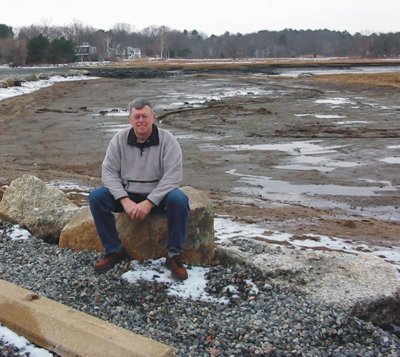
Gulf Voices: Alan Ammann's passion for wetlands
Printer Friendly Page
By Cathy Coletti
 |
Alan Ammann in Rye, New Hampshire. Now retired, Ammann continues to cover state and local restoration projects and educate communities about the value of wetlands.
|
ALAN AMMANN, of Lee, New Hampshire, is a persuasive guy. He once convinced a North Hampton resident to temporarily move his seasonal home so workers could restore a neighboring salt marsh.
“It was a little shocking for him at first. But he recognized that there was a problem. A few years earlier, he had found the house ripped from the foundation and floating on Route 1A,” said Ammann.
Two outdated culverts built in the 1940s were the problem. They couldn't handle the amount of water that needed to pass under Route 1A, and they also couldn't provide the essential ingredient to the salt marsh: salt. The Little River Salt Marsh was being choked to death. In the late 1990s, two new and much larger culverts restored tidal flow to the marsh, helping to alleviate the flooding.
Ammann's vision and willingness to ask “What if?” makes him a mover and shaker in the salt marsh restoration world. A panel of wetland experts selected him as one of this year's winners of the National Wetlands Awards, given annually by the Environmental Law Institute to recognize wetlands conservation efforts.
If asked about the value of wetlands, Ammann cites their flood mitigation, wildlife habitat, educational, aesthetic and economic values. Then, he will go on to describe another value that is harder to put your finger on, what he calls intrinsic values.
“The Statue of Liberty is useful to pilots guiding ships in and out of New York City harbor, but that's not why we preserve it. Like motherhood and apple pie, it stands for a bigger ideal,” Ammann said.
Wetlands are part of our heritage, he said. They were responsible for a great deal of the resources that allowed the United States to flourish. Wetlands are monuments to the powerful connection humans have to the natural world. Without wetlands, we do not survive.
Cathy Coletti is the outreach coordinator for the New Hampshire Coastal Program. She serves on the Gulf of Maine Times editorial board.
As a boy growing up in Florida, Ammann came home from school one day and, like every day, went to play in the woods near his home. He then found himself face to face with a bulldozed area and a profound sense of loss. This experience sticks with Ammann today and drives his lifelong interest in and passion for conservation.
In the early 1990s, Ammann spearheaded a project to inventory all of the potentially restorable salt marshes in New Hampshire. The resulting document, a catalog of available projects, jump-started interest, enthusiasm, and action among coastal towns and other agencies. Most of the ensuing restoration projects and partnerships were a result of his inventory. Ammann's pioneering work also includes developing a new method for the evaluation of wetlands in New Hampshire.
Ammann's 28-year career with the Natural Resources Conservation Service (NRCS) has taken him to Pennsylvania and all of the New England states in a variety of roles, including soil conservationist, wildlife biologist and water quality specialist. With all of this experience, Ammann says he feels a special tie to New Hampshire's wetlands and adds that New Hampshire is his adopted home state. Now retired, he continues to work toward restoration as both a consultant to NRCS and as a volunteer.
Ammann notes, “As long as I'm able, I'll continue to do this work.”

© 2006 The Gulf of Maine Times